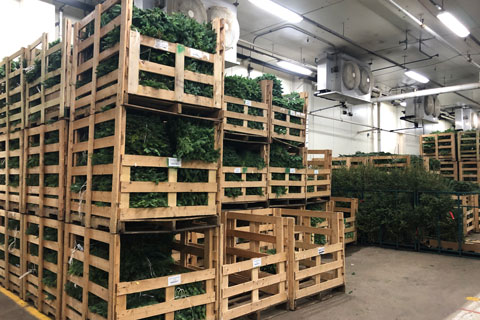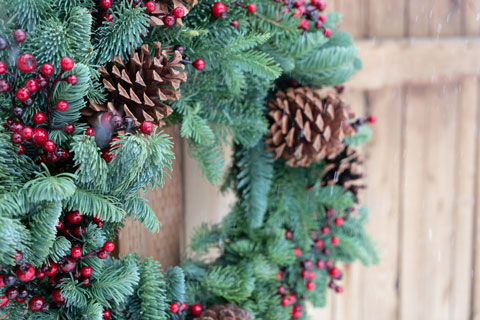1/1/2022
A Fresh Look at Greenery
Ann-Marie Vazzano
Each holiday season, consumers have come to expect plentiful fresh boughs, garlands, wreaths and Christmas trees wherever they look—garden centers, big box stores and even their local grocery stores. But this past year, fresh greenery, like most commodities, was harder to come by.
The reasons for the shortage are myriad, from logistical issues with trucking and labor to a simple lack of trees, according to Shannon Kuhrt, vice president of greenery supplier M&M Wintergreens Inc. She points to scorching temperatures in the Pacific Northwest this past summer that damaged some of the trees, causing suppliers to scramble to source product elsewhere, resulting in delays.
But there’s also an overall increase in demand.
“I think this demand is being driven as consumers learn that fresh holiday decorations are sustainably made and beneficial to the environment, as well as having mental health benefits by the phytoncides (AKA essential oils) given off by the fresh greens,” Shannon says.
With that increased demand comes another problem—one Shannon says is impacting the entire greenery industry: Christmas creep.
“Hallmark can start to play Christmas movies before Halloween and Christmas music can start playing November 1, but fresh greenery has a timetable all its own,” she explains, noting that evergreens require a hard frost to set needles.
 While the season used to start after Thanksgiving, consumers now expect access to greenery as early as October, which is virtually impossible from a logistical standpoint.
While the season used to start after Thanksgiving, consumers now expect access to greenery as early as October, which is virtually impossible from a logistical standpoint.
But, she says, garden retailers can help by recognizing the challenges fresh greenery suppliers face and continuing to accept product throughout November. They also can explain to customers that fresh greenery is a different animal from the holiday hardgoods that start cropping up in October.
“It would be like selling vegetable plants in northern states in February,” Shannon says. “It’s just not possible or smart.”
Pictured: M&M Wintergreens in Cleveland gets primed for live greens shipping season.
F.J. Trzuskowski, vice president of sales at fresh-cut greenery supplier Continental Floral Greens, agrees that garden retailers need to be understanding when certain products aren’t available. In addition to suppliers having to look harder to find quality material, it’s gotten a lot more expensive, too. The cost of trucking, he says, was astronomical this past year, but they have to pay those prices just to keep product moving.
 “We’re making substitutions where we have to,” F.J. adds, noting that overall, the industry has been very cooperative and understanding during these challenges. His advice? “Be flexible, be creative and have fun.”
“We’re making substitutions where we have to,” F.J. adds, noting that overall, the industry has been very cooperative and understanding during these challenges. His advice? “Be flexible, be creative and have fun.”
Pictured: All holiday wreaths from Continental Floral Greens start with a High Mountain Blue Noble base.
Adapting to Market Changes
While the pandemic and its impact on logistics has certainly exacerbated some of the fresh-cut greenery industry’s challenges, Jerry Kamysiak, owner and president of fresh Christmas décor supplier Maple Ridge Supply, says it’s not the only contributing factor. He notes there simply aren’t enough Fraser firs to keep up with demand for that variety, both in terms of fresh-cut trees and boughs.
Fraser firs, with their vibrant color and excellent needle retention, have become the prominent choice for fresh-cut greenery at garden centers and big box retailers, he says. This high demand has been unsustainable, due in part to a shortage of Fraser fir transplants, which take four years to grow.
Jerry says retailers can adapt, though, by not relying so much on Fraser firs. For pots, he recommends using Norway pine (sometimes called red pine), which features long needles and stiff branches that work well in the top section of tall pot designs. He adds that while all pines offer excellent needle retention, the longer the needle, the better the retention. Because red pine is often planted as a timber tree in the Midwest, these boughs are abundant and more affordable.
He also suggests avoiding Fraser fir for grave blankets because needle retention isn’t as critical in an outdoor setting where needle loss is less noticeable. Balsam firs or spruce would be good options instead..
Growing Sales
Assuming you can get the product, what can a retail garden center do to boost sales and compete with the big box stores? F.J. says independent retailers need to try to fill a niche in the market by offering higher-end products and adding value with items such as unique bows and other decorative components.
“You’ve got to stand out,” he says. “It’s gotten so competitive—I think it’s hard for a small garden center to compete against a Lowe’s or Home Depot on just a basic, everyday wreaths.”
In addition to offering unique trimmings, he suggests giving customers the option to purchase a complete fresh greenery bundle, which might include a wreath, a table runner, a garland and a tree.
Keeping a close eye on trends can help boost sales, too. Shannon says that as Baby Boomers downsize and decorate less, she’s seeing a shift away from white pine roping in favor of what she refers to as “Instagram-worthy, heavier, mixed garlands.”
“Be willing to try something new,” she adds. “While most of our customers carry a wide variety of products and are open to trying new things, there are still far too many that simply duplicate the same order year after year. While it may feel safe, that mindset is not exciting for the consumers and it won’t provide the opportunity for growth.”
Ann-Marie Vazzano is a freelance writer and editor based in Northeast Ohio. She can be reached at amvazzano@gmail.com.
Greenery Handling Best Practices
Jerry Kamysiak, owner and president of Maple Ridge Supply, offers some tips for retailers to get the most out of their fresh-cut greenery:
• If you buy large volumes of fresh greenery, pay attention to needle retention qualities of different varieties and time your deliveries accordingly.
• When boxed greens arrive, open the box and remove them right away, as boxes can draw in moisture and diminish quality.
• Store greens outdoors on the north side of a building.
• Stand the bundles upright (not on concrete), on the cut ends, and keep them out of direct sun. Use shade cloth if necessary.